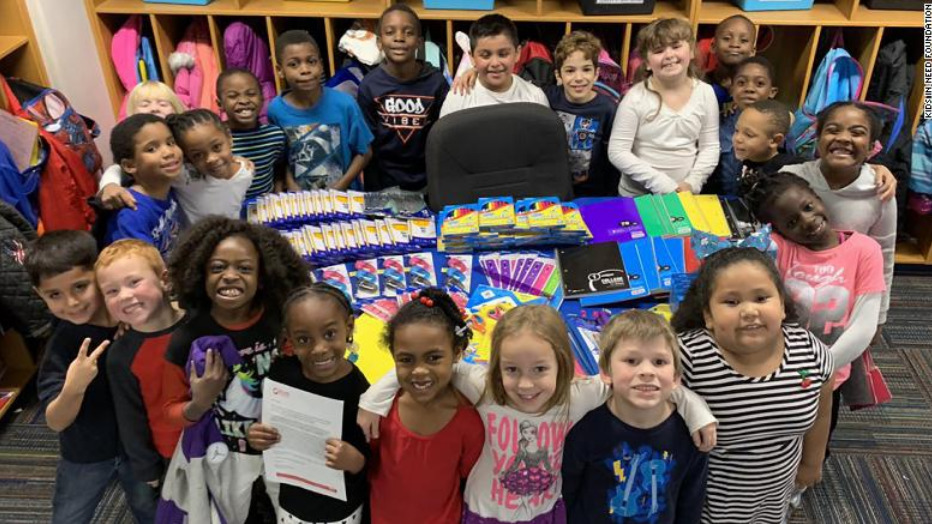15 million children don’t have money for school supplies. Here’s how you can help them

Thank you, CNN for featuring our mission—to provide *food supplies* for kids across the country this school year.
Going back to school can be scary for kids. There’s peer pressure, homework and tests. But 15 million children living in extreme poverty in the US face far more basic fears — not having the supplies to learn or not knowing where they’ll get their next meal, especially on weekends. Here’s what’s being done and how you can help.
When a teacher hands out a list for parents of basic school supplies, it’s a real problem for at least one in five children in the US who live below the federally defined poverty line.
“We know most, if not all of (those children), go to school without some or all of the supplies,” says Dave Smith, executive director of the Kids in Need Foundation. “Parents shouldn’t have to decide between school supplies and putting food on the table.”
In many districts, Smith says, teachers don’t even publish a list because they know parents can’t afford the items.
Deana Venturi, who teaches English at a magnet school in St. Paul, Minnesota, has never handed a supply list to the kids because 90% of them are in poverty. She spends her own money on supplies — $1,000 to $1,500 a year, she says.
“I hide what I spend from my sister (who is an accountant) because I don’t want her to know,” says Venturi. “It’s one thing students don’t have to worry about so much and they can focus on learning.”
Her school does not provide a budget specifically for school supplies. She gets a $200 stipend for the school year.
Without supplies, students can’t participate in the lesson, says this 20-year teaching veteran. “Academically, they won’t do well.”
Venturi also points out the stigma around not being prepared.
“Having a backpack if everyone has a backpack, having a notebook and pencils and really wanting to do the right thing,” says Venturi. “They want to do well.”
Kids in Need Foundation has been trying to remedy this problem for 24 years. The nonprofit provides free supplies to teachers through “resource centers” that look like small office-supply stores. Teachers receive a number of points and can shop the aisles. Resource centers are in 43 big cities, including New York, Miami, Atlanta, Chicago, and Portland, Oregon.
The supplies take the burden off low-income families and the teachers who serve them.
Venturi has been shopping twice annually at the Minneapolis resource center for years. She gets some $300 worth of supplies.
You can make an impact by donating supplies or cash to that program or you can volunteer at a resource center.
Kids in Need also has programs where individual donors or corporate sponsors pay for backpacks full of school supplies to be given to a classroom, school or district.
“A donor can say I want to support ‘X’ school,” says Smith.
A gift of $25 will pay for a backpack and 20 items: notebooks, folders, pencils, glue sticks, erasers, a ruler, pencil pouch and crayons. Last year the organization says it supplied more than 6 million students and 200,000 teachers. The goal is to reach 10 million students every year.
“It’s a problem that together we should be able to solve.”
Those same children whose families can’t afford school supplies are often also struggling with hunger. Federal school lunch programs provide free or reduced-price breakfast and lunch only during the school week. The weekend is another story.
“It’s about a 65-hour gap that these children have very little or nothing to eat in a lot of cases,” says Nikki Grizzle with the nonprofit Blessings in a Backpack.
Every year, teachers see children come back from the summer desperate for access to the school cafeteria, says Grizzle. “Can you imagine being a small child trying to learn, retain and sit still in a chair when really all you can think about is the hunger in your stomach?”
Blessings in a Backpack provides backpacks filled with non-perishable food to children before they leave school on Fridays. It’s stocked to sustain them through the weekend. Their menus are evaluated by dieticians.
Last year the program fed 87,000 students in 47 states, and it’s looking to grow.
“We can start a Blessings program for as little as $130 that will feed one child every weekend for the entire school year.”
Blessings in a Backpack also works with other weekend food programs to make sure they aren’t duplicating efforts.
Grizzle says it takes a village to cover the 13 to 15 million food-insecure children in the US.
You can donate to their backpack program, volunteer to pack backpacks in your community, or sponsor an entire school in need.
“Understand this is a problem in everyone’s community,” says Grizzle. “Even the most affluent communities in the US have a need.”
